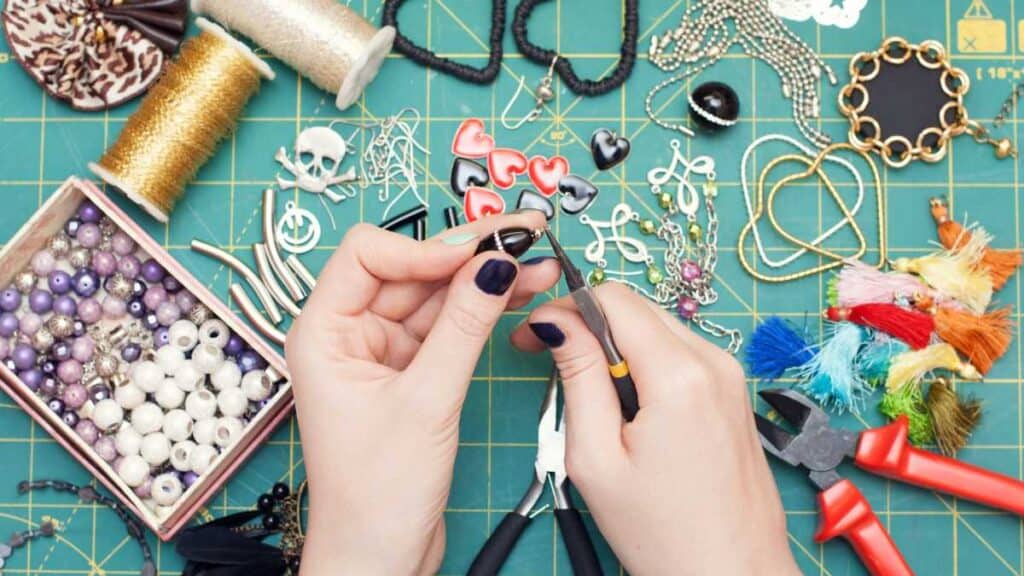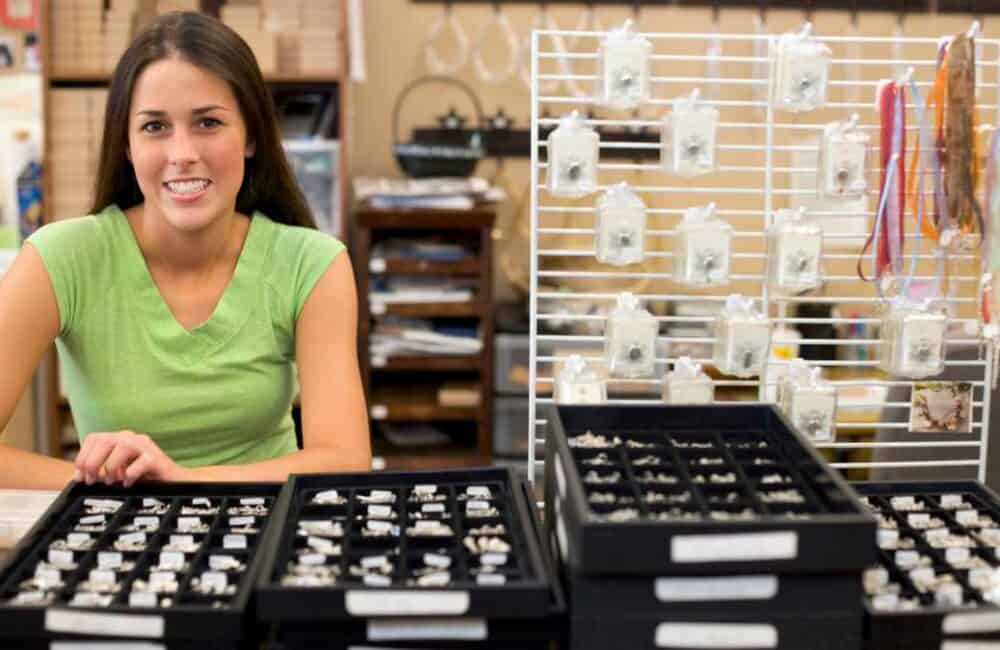Starting a jewelry business can be an exciting and rewarding venture. Did you know that the global jewelry market was valued at approximately $353.26 billion in 2023 and is expected to grow at a compound annual growth rate (CAGR) of 4.7% from 2024 to 2030?
This booming industry offers endless opportunities for creativity and entrepreneurship. In this guide, I’ll walk you through everything you need to know to start your own jewelry business, from understanding the market to scaling your operations.
How to Start a Jewelry Business: Steps
1. Understanding the Jewelry Market
Market Trends
The jewelry market is constantly evolving, with new trends emerging every year. One of the most significant trends is the rise of lab-created diamonds. These diamonds are virtually indistinguishable from natural diamonds and are gaining popularity due to their ethical and environmental benefits. Additionally, personalized and custom-made jewelry is in high demand, allowing consumers to express their individuality.
Common Question: Why are lab-created diamonds becoming so popular? Lab-created diamonds offer the same brilliance and durability as natural diamonds but are often more affordable and environmentally friendly. They appeal to consumers who are conscious of ethical sourcing and sustainability.
Target Audience
Understanding your target audience is crucial for success. The primary consumer segments in the jewelry market include:
- Millennials and Gen Z: These younger consumers are interested in sustainable and ethically sourced jewelry. They value unique, personalized pieces and are willing to pay a premium for products that align with their values.
- High-Income Earners: This segment views jewelry as a status symbol and is often interested in luxury and high-end pieces. They are less price-sensitive and more focused on quality and exclusivity.
- Gift Buyers: Jewelry is a popular gift for special occasions such as weddings, anniversaries, and birthdays. Understanding the preferences and buying behaviors of gift buyers can help you tailor your marketing strategies.
Personal Experience: When I first started exploring the jewelry market, I attended a trade show where I saw the incredible craftsmanship and creativity that goes into making each piece. This experience opened my eyes to the importance of understanding market trends and consumer preferences. I realized that sustainability was becoming a significant factor for many buyers, which influenced my decision to focus on ethically sourced materials.
2. Finding Your Niche

Types of Jewelry
The jewelry market is diverse, with various categories catering to different tastes and budgets. Here are some main types of jewelry:
- Fine Jewelry: Made from precious metals like gold, silver, and platinum, often featuring gemstones such as diamonds, rubies, and sapphires.
- Fashion Jewelry: Also known as costume jewelry, made from less expensive materials like base metals, glass, and synthetic stones.
- Handmade Jewelry: Crafted by artisans, often incorporating materials like beads, wire, and natural stones.
- Vintage and Antique Jewelry: Pieces with historical significance, collected for their rarity and craftsmanship.
- Ethical and Sustainable Jewelry: Made from recycled materials or ethically sourced gemstones and metals.
Common Question: How do I choose the right type of jewelry to sell? Consider your passion, skills, and market demand. If you love working with natural stones, handmade jewelry might be your niche. Research market trends and identify gaps where you can offer something unique.
Niche Selection
Choosing the right niche is crucial for standing out in the competitive jewelry market. Here are some tips:
- Align with Your Passion: Your enthusiasm will drive your creativity and business success.
- Research Market Demand: Use tools like Google Trends and industry reports to identify what types of jewelry are currently in demand.
- Consider Your Skills and Resources: Assess your skills and the resources available to you.
- Identify Your Target Audience: Think about who your ideal customers are and what they value.
- Evaluate Competition: Analyze your competitors to see what they are offering and how you can differentiate yourself.
Personal Experience: When I was exploring different niches, I felt overwhelmed by the options. I spent hours researching and even took a few jewelry-making classes. One key insight was the growing trend of sustainable and ethical jewelry. This led me to focus on creating a line of sustainable jewelry made from recycled metals and ethically sourced gemstones.
3. Creating a Business Plan
Business Model
Your business model will determine how you produce and sell your jewelry. Here are some common models:
- Handmade: Creating each piece by hand, which allows for unique designs but can be time-consuming.
- Dropshipping: Partnering with suppliers who handle inventory and shipping, allowing you to focus on marketing and sales.
- Wholesale: Buying jewelry in bulk from manufacturers and selling it at a markup.
Common Question: Which business model is best for a new jewelry business? It depends on your skills, resources, and goals. Handmade jewelry allows for creativity and uniqueness, while dropshipping and wholesale can be more scalable.
Financial Planning
Creating a solid financial plan is essential. This includes budgeting for materials, tools, marketing, and other expenses. Consider funding options such as personal savings, loans, or investors.
Personal Experience: When I started my jewelry business, I underestimated the initial costs. I quickly learned the importance of detailed financial planning and setting aside a contingency fund for unexpected expenses.
Legal Requirements
Ensure you comply with all legal requirements, including registering your business, obtaining necessary licenses, and adhering to regulations.
Common Question: What legal steps do I need to take to start a jewelry business? Register your business name, obtain any required licenses or permits, and ensure you comply with local regulations regarding sales and manufacturing.
4. Designing and Sourcing Jewelry

Design Process
Creating unique designs is key to standing out. Start with sketches and prototypes, and consider using CAD software for more complex designs.
Common Question: How do I create unique jewelry designs? Draw inspiration from various sources, including nature, art, and current fashion trends. Experiment with different materials and techniques to develop your style.
Sourcing Materials
Finding reliable suppliers for materials and tools is crucial. Look for suppliers who offer high-quality materials at competitive prices.
Personal Experience: I spent a lot of time researching suppliers and building relationships with them. This ensured I had a steady supply of high-quality materials for my jewelry.
Manufacturing Options
Decide whether to produce your jewelry in-house or outsource production. In-house production allows for more control, while outsourcing can be more cost-effective.
Common Question: Should I produce my jewelry in-house or outsource? Consider your budget, production volume, and quality control needs. In-house production offers more control, but outsourcing can save time and reduce costs.
5. Setting Up Your Workspace
Home Studio Setup
If you’re starting from home, set up a dedicated workspace with essential tools and equipment. This includes a workbench, lighting, and storage for materials.
Common Question: What tools do I need for a home-based jewelry business? Basic tools include pliers, wire cutters, a soldering kit, and a polishing machine. Invest in quality tools to ensure precision and durability.
Professional Studio
As your business grows, you might consider renting or setting up a professional workspace. This allows for more space and advanced equipment.
Personal Experience: I started my business from a small corner in my apartment. As my business grew, I moved to a dedicated studio space, which allowed me to expand my operations and improve efficiency.
6. Building Your Brand
Brand Identity
Creating a compelling brand story, logo, and visual identity is crucial for attracting customers. Your brand should reflect your values and the unique qualities of your jewelry.
Common Question: How do I create a strong brand identity? Start with a clear brand story that communicates your mission and values. Design a logo and visual elements that reflect your brand’s personality.
Packaging and Presentation
Design attractive packaging that reflects your brand and enhances the customer experience. Consider eco-friendly packaging options to appeal to environmentally conscious consumers.
Personal Experience: I invested in custom packaging that included recycled materials and a handwritten thank-you note. This small touch made a big difference in customer satisfaction and loyalty.
7. Creating an Online Presence
Website Development
Choose a platform for your website, such as Shopify or WordPress, and set up e-commerce functionality. Ensure your site is user-friendly and visually appealing.
Common Question: What platform should I use for my jewelry website? Shopify is a popular choice for e-commerce due to its ease of use and robust features. WordPress with WooCommerce is another flexible option.
SEO and Content Marketing
Implement SEO strategies to drive organic traffic to your site. Create valuable content, such as blog posts and videos, to engage your audience and improve your search rankings.
Personal Experience: I started a blog on my website where I shared jewelry care tips and behind-the-scenes stories. This not only improved my SEO but also helped build a connection with my audience.
Social Media Marketing
Leverage platforms like Instagram, Pinterest, and TikTok to showcase your jewelry. Use high-quality images and engaging content to attract followers and drive sales.
Common Question: How can I effectively market my jewelry on social media? Post regularly, use relevant hashtags, and engage with your followers. Collaborate with influencers and run promotions to increase visibility.
8. Marketing and Sales Strategies
Pricing Your Products
Pricing your jewelry competitively while ensuring profitability is crucial. Consider factors such as material costs, labor, and market demand.
Common Question: How do I price my jewelry? Calculate your costs, including materials and labor, and add a markup that reflects your brand’s value. Research competitors’ pricing to ensure your prices are competitive yet profitable. For example, if your total cost to produce a necklace is $50, and you want a 50% profit margin, you would price it at $75.
Personal Experience: When I first started, I struggled with pricing my pieces. I realized that underpricing not only affected my profitability but also the perceived value of my jewelry. After researching competitors and understanding my costs better, I adjusted my prices to reflect the quality and uniqueness of my designs.
Sales Channels
Exploring various sales channels can help you reach a broader audience. Here are some options:
- Online Marketplaces: Platforms like Etsy, Amazon Handmade, and eBay allow you to reach a global audience.
- Your Website: Selling directly through your website gives you more control over branding and customer experience.
- Pop-Up Shops: Temporary retail spaces can help you connect with local customers and test new markets.
- Retail Partnerships: Partnering with local boutiques or larger retailers can increase your visibility and sales.
Common Question: Which sales channel is best for a new jewelry business? It depends on your target audience and resources. Online marketplaces are great for reaching a wide audience with minimal upfront costs, while your website allows for complete control over branding. Pop-up shops and retail partnerships can help build local presence and customer relationships.
Personal Experience: I started by selling on Etsy, which helped me reach a global audience quickly. As my brand grew, I launched my own website to have more control over the customer experience and branding. I also participated in local pop-up shops, which were fantastic for building community connections and getting direct feedback from customers.
Customer Engagement
Building a loyal customer base is essential for long-term success. Here are some strategies:
- Excellent Customer Service: Respond promptly to inquiries, handle issues professionally, and go the extra mile to make customers feel valued.
- Personalized Communication: Use email marketing to send personalized messages, such as birthday discounts or product recommendations based on past purchases.
- Loyalty Programs: Offer rewards for repeat purchases, referrals, or social media engagement.
Common Question: How can I build a loyal customer base? Focus on providing excellent customer service and creating a personalized experience. Engage with your customers through social media, email marketing, and loyalty programs to keep them coming back.
Personal Experience: I implemented a loyalty program that rewarded customers with points for every purchase, which they could redeem for discounts on future orders. This not only encouraged repeat business but also made customers feel appreciated and valued.
9. Scaling Your Business
Inventory Management
Efficient inventory management is crucial as your business grows. Use tools and techniques to keep track of your stock levels, sales, and reordering needs.
Common Question: How do I manage inventory effectively? Use inventory management software to track stock levels, set reorder points, and generate reports. Regularly review your inventory to identify slow-moving items and adjust your purchasing strategy accordingly.
Personal Experience: I started using inventory management software early on, which helped me avoid stockouts and overstocking. This allowed me to maintain a balanced inventory and meet customer demand efficiently.
Hiring and Training
As your business grows, you may need to hire additional help. Consider when and how to hire employees or contractors to support your operations.
Common Question: When should I hire additional help? Hire when you constantly struggle to keep up with demand or when specific tasks require expertise you don’t have. Start with part-time or freelance help to manage costs and scale up as needed.
Personal Experience: I hired my first employee when I realized I was spending too much time on administrative tasks instead of designing new pieces. This allowed me to focus on growing the business while ensuring day-to-day operations ran smoothly.
Expanding Product Lines
Diversifying your product offerings can attract new customers and increase sales. Consider adding complementary products or new jewelry lines.
Common Question: How do I decide which new products to add? Analyze customer feedback, market trends, and sales data to identify opportunities. Start with small batches to test new products and gather feedback before scaling up.
Personal Experience: I expanded my product line by introducing a collection of personalized jewelry, which quickly became popular. Listening to customer feedback and staying attuned to market trends helped me make informed decisions about new product offerings.
10. Sustainability and Ethical Practices
Sustainable Materials
Sourcing eco-friendly materials and reducing waste can appeal to environmentally conscious consumers. Look for suppliers who offer recycled metals and ethically sourced gemstones.
Common Question: How can I make my jewelry business more sustainable? Use recycled materials, minimize waste, and adopt eco-friendly packaging. Communicate your sustainability efforts to customers to build trust and loyalty.
Personal Experience: I switched to using recycled metals and eco-friendly packaging, which resonated well with my customers. Sharing the story behind my sustainable practices helped build a loyal customer base that values ethical and environmentally friendly products.
Ethical Production
Ensuring fair labor practices and ethical sourcing is essential for building a reputable brand. Work with suppliers who adhere to ethical standards and treat their workers fairly.
Common Question: Why is ethical production important? Ethical production ensures that your products are made in a way that respects workers’ rights and the environment. It builds trust with customers and aligns your brand with positive values.
Personal Experience: Partnering with suppliers who prioritize ethical practices has been a cornerstone of my business. It not only ensures the quality and integrity of my products but also aligns with my values and those of my customers.
Conclusion
Starting a jewelry business is a rewarding journey that combines creativity with entrepreneurship. By understanding the market, finding your niche, creating a solid business plan, and implementing effective marketing and sales strategies, you can build a successful and sustainable jewelry brand. Remember, the key to success lies in staying true to your values, continuously learning, and adapting to market trends.
Call to Action: Ready to start your jewelry business? Take the first step today by researching your niche and creating a business plan.








